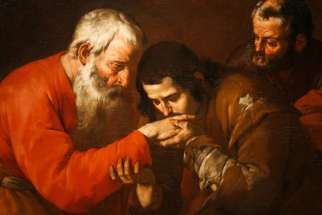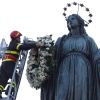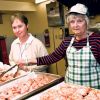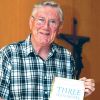Focus on what is found, not what is lost
Sometimes everything can seem right on the surface while, deep down, nothing is right at all. We see this, for example, in the famous parable in the Gospels about the Prodigal Son and his older brother. By every outward appearance the older brother is doing everything right: He’s perfectly obedient to his father, is at home and is doing everything his father asks of him. And, unlike his younger brother, he’s not wasting his father’s property on prostitutes and partying. He seems a model of generosity and morality.
Gospel is good news of freedom from sin, selfishness, death, Pope says
75 years living the Gospel
The Felician Sisters this year look back on 75 years of careful, quiet and competent work on behalf of people the rest of us have brushed aside.
A human scale and a human touch have been their hallmark.
“Our goals are more modest in terms of structures and things like that,” explains Felician Sister Shelley Marie Jeffrey. “We just think it’s more important to touch people’s spirit than to be behind something that people will look at and say ‘Wow.’ ”
In 1937, in the teeth of the Great Depression, most of the sisters were Polish immigrants or daughters of Polish immigrants. They arrived in a poor, immigrant neighbourhood near Dundas and Bathurst Streets where men were unemployed or on the road or both and women were struggling to keep families together and their kids in school.
The sisters set themselves up as go-betweens, translating and interpreting the English world to the Polish immigrants, helping the kids with homework, gathering women to talk over troubles and challenges, keeping the youngest safe and occupied.
In the forms of after-school programs, youth drop-ins, ESL classes for adults and computer classes, the work the Felicians began in 1937 continues today.
“We still work with immigrants. There are a lot of families whom we serve that are new to Canada,” Jeffrey said.
In 1937 the broken economy produced its share of broken people. That hasn’t changed either. The sisters still feed and clothe people who are never going to be contributors to the economy.
“The people we serve are the lepers of society,” Jeffrey said. “I don’t mean that in a derogatory way. But they’re the outcast people that we don’t want around. They’re mentally ill.They’re addicted. They don’t present themselves very well.”
Hot meals and clean clothes available at the St. Felix Centre only open the door to what the Felicians really offer to the poor, said St. Felix Centre executive director Paddy Bowen.
“We are not in the business of changing people. We are in the business of accepting them — where they are and what they are.”
Foundations and governments mostly want agencies to fix the poor — get them jobs, find housing, cure addictions and illnesses. There’s nothing wrong with that, but the sisters are there for a different purpose, said Bowen.
“We are actually not in the fixing or changing or transforming arena. Although, what you find of course is that there is nothing more transforming than being accepted,” she said.
The next step after acceptance is community. By offering people meals in a human-scale, intimate dining room and allowing time to sit and talk, the sisters have for years invited people into their community. It’s that sense of community that makes the St. Felix Centre a little different from the 75 other drop-ins in Toronto.
The St. Felix Centre community extends well beyond the poor, homeless and socially isolated. The centre runs with just seven full-time staff and 450 volunteers.
But this last year the invitation has gone a step further. The Felicians no longer live in the gingerbread mansion that was their convent back in 1937. A group of women and their children now occupy the house, which will soon undergo renovations so it can comfortably house even more.
“We developed that program specifically not to be a rooming house,” said Jeffrey. “But to be a community. That’s what we know. We know the value of it and we know the challenges of it.”
It’s a classic case of a religious order sharing its charism — letting everybody in on their mission.
“Our call is to live in Franciscan community. It is to live in simplicity. It’s to be responsive,” Jeffrey said. “We’re not unique in that, but we find ways to be unique. We’ve never specialized in one ministry. There are no two people in our community doing the same thing.”
Nor are the Felicians satisfied to keep doing the same thing year after year.
The neighbourhood around the St. Felix Centre is changing rapidly with injections of new money , condos and professionals who choose a downtown lifestyle. The sisters have been looking around to see where their talent for creating community might be needed more.
At 2195 Jane St., a 46-year-old, 11-storey tower operated by Toronto Community Housing Corp., the sisters have launched a weekly communal dinner for Jane- Finch residents. Depending how local partners and the community react, the program may expand to seven days a week.
For the sisters, discernment means slowly and carefully figuring out what people really need and how they can help.
“Given our resources, given our experience, what can we offer that other people can’t?” is the central question, said Jeffrey.
“The Felicians are down to under 40 in Canada,” said Bowen. “How often do we see a group of people who just selflessly dedicate their lives to living for other people?
“The new evangelization is terribly challenging but it’s also really exciting,” said Jeffrey. “Our main approach to evangelization here is, we don’t try to evangelize except by the way we live the Gospel values.”
Brian Brown bridges three religions in new book launching
TORONTO - Faith is a difficult subject to bring up with our children, our own flesh and blood. How many of us would endure earnest talk of faith from friends? A combination of courage and psychopathology is necessary before most Christians can talk about faith with strangers. So, what chance does interfaith dialogue really have?
Brian Brown is not so easily dissuaded. The United Church minister and prolific author is convinced all we need is the right starting point.
“The most basic approach is to go to each others’ Scriptures,” he told The Catholic Register. “If we’re to understand what each other aspires to be, the place to begin is each others’ Scriptures.”
That’s the premise behind Three Testaments: Torah, Gospel and Quran. Brown has assembled Muslim, Christian and Jewish scholars to introduce modern, readable translations of the three texts. The scholars explain how the holy books of each community are used and understood within the faith they represent.
In the 21st century the three Abrahamic faiths do not occupy separate patches of the globe, or even separate social spheres. The three major faiths of the West rub shoulders daily, and we have the wars to prove it. For Brown, getting past the dialogue of caricatures, suspicion, fear and resentment is a matter of life and death.
“It’s an antidote to the burning of the Quran,” he said.
It’s not just terror attacks in far off capitals, or sick minds blowing up cars and shooting up theatres, that has Brown concerned. Ordinary Christians, Muslims and Jews have all been touched by the toxic stew of interfaith ranting, slander and innuendo.
“I had a person tell me they were a little afraid to go to the hospital in Niagara Falls because most of the doctors are Muslim. These are good, sensible Christian people who are influenced by those bomb makers and now need to hear from the Scripture authorities,” he said. “Eighty per cent of Christians — and I’m guessing 80 per cent of Muslims and Jews — are so negatively impacted by the bombers and bloggers that good, proper-thinking Christian people getting e-mails that are cockeyed develop strange notions about their Muslim neighbours or their Jewish neighbours.”
David Bruce, a United Church minister for 25 years who is now the lay Catholic director of The Good Neighbours’ Club for homeless men in Toronto, introduces the Gospel in Three Testaments. With doctorates from California’s Fuller Theological Seminary and Toronto’s University of St. Michael’s College, Bruce believes the Three Testaments approach works because it’s based on solid scholarship and aimed at ordinary, intelligent readers.
“Anybody who picks up a National Geographic and enjoys the articles should be able to enjoy Three Testaments,” he said.
It’s also successful because the book isn’t trying to cram three different religions into a single test tube of kind and fluffy thoughts.
“There’s an increasingly large proportion of Western Christianity that says there really isn’t any difference in the world religions if you boil it all down,” said Bruce. “We’re not saying that. We’re saying that there are real differences but that doesn’t mean we can’t stand side by side and listen to one another.”
The book is meant to be read by people of faith. It’s not an outsider’s sociological analysis of religion as a curious phenomenon among certain classes of people.
“All of this is written by believers to believers of other faiths,” said Bruce.
As such it’s the antidote to common distortions that hijack religion, said Brown.
“Scriptures are abused and can be made to say things. This project is a joint project of Christian, Jewish and Muslim scholars to run counter to that, to say, ‘Let the Scriptures speak for themselves.’ ”
The book is as much a cause as it is literature. Brown wants it read in seminaries and on university campuses. The book launch will take place in seven cities, beginning at Ground Zero in New York. New York launch events include a Sept. 9 interfaith rally in St. Peter’s Church next door to Ground Zero. In Washington Sept. 10-12 during the thick of the presidential campaign the Three Testaments launch at the Canadian Embassy will feature ambassadors, religious leaders and Amir Hussain, editor of the Journal of the American Academy of Religion who wrote the foreword to Three Testaments. In Dallas-Fort Worth Sept. 12-13 the book will be presented to the George W. Bush Presidential Library. In Los Angeles Sept. 14-15 the launch brings together Christians, Jews and Muslims for Temple Beth Am’s Shabbat service. The Jesuit University of San Fransisco host the Abrahamic faiths for an event Sept. 16-18. Kazi Publications, the most important Muslim publisher in America, hosts the Chicago launch Sept. 19-20. Toronto gets its turn Sept. 23-30 at the Royal Ontario Museum.
The book also has something to say to people who dismiss religious thinking or think religious people incapable of solving religious conflict, said Bruce.
“There is a stereotype out there that anybody who is actually committed to one of the three great Western faiths has somehow parked at least a section of their brains — they’ve put it in neutral. That’s just not the case,” he said. “In fact, the best scholarship in all three religions is by those who actually practise the faith.... It’s important for the three Abrahamic religions to hear each other on their own terms. When you bring them so close together in a single volume, they don’t really have any choice.”





